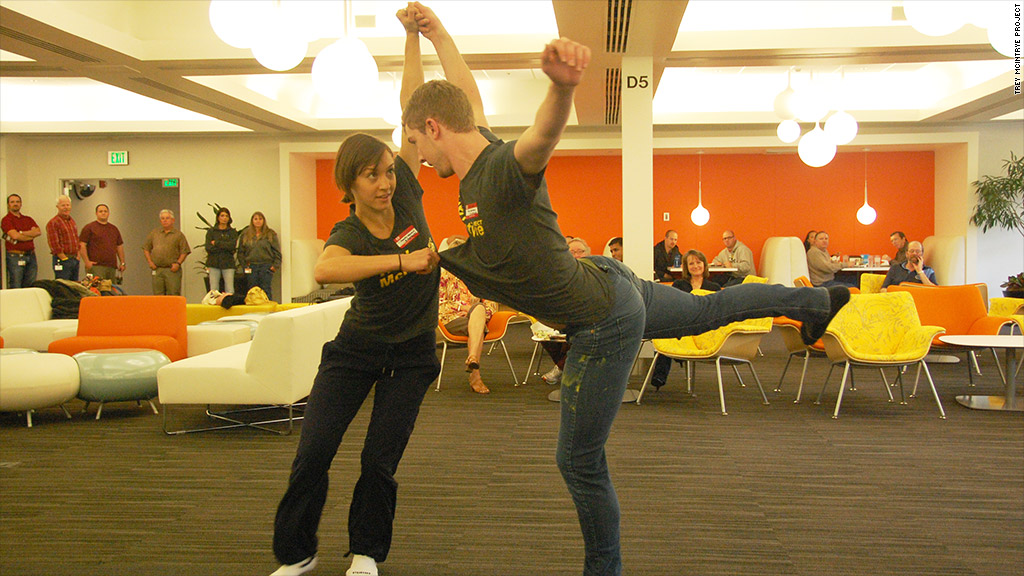
Editor's note: An earlier version of this story mischaracterized the relationship between Hewlett-Packard and the Trey McIntyre Project. The dance troupe has performed at HP's Boise office several times as part of a company event showcasing the area's artistic organizations and charities, but HP has not hired or paid TMP for its creative services. The text of this article has been updated and corrected. CNNMoney regrets the error.
Most dance companies make money by selling tickets to their performances. Boise-based troupe Trey McIntyre Project has a more expansive business model: "We've decided that we have a real asset, which is the creative process itself. We're selling that," says John Michael Schert, the company's co-founder and executive director.
Some corporate giants are interested in the pitch. The University of Chicago Booth Business School recently brought Schert in for advice on getting inspired, and several Boise businesses have teamed up with the dance company.
"Artists live the whole process of inspiration. We decided to refine it as a tool," says Schert, a former dancer himself. "We want companies to understand what they are creating, whether it is a marketing strategy or a healthcare policy, and get them to think about where they get hung up, and how to find ways around those stopping points to come up with new ideas."
Tech giant Hewlett-Packard (HPQ) likes the troupe's creativity. Von Hansen, the company's general manager of future technologies, has brought TMP's dancers to HP's Boise office several times to perform as part of the company's annual outreach to local nonprofits and artistic organizations.
Watching the dancers in action and talking with them afterward about their creative process "pulls our staff out of the same way we do things so that we can better design solutions and solve problems," he says.
HP doesn't pay TMP for its services, but some corporate clients do. TMP's rates for its "engagement" line of business start at around $20,000 for a half-day presentation featuring four members of its dance company. Each presentation is tailored for the specific customer and its goals.
Real estate developer Clay Carley worked with Schert to help his team brainstorm plans for a new mixed-use property in Old Boise, a downtown commercial district.
"We've gotten some unusual ideas," he says. "They've helped us with how to imagine the space in non-traditional ways, such as circular rooms, and ideas for amenities."
Related story: How IDEO brings design to corporate America
Hiring motivational speakers, performers and artists to inspire corporate cube-dwellers is a time-honored tradition at big companies. Tracking the ROI on such ventures is tricky, researchers admit. There's very little hard data out there, says Barry Jaruzelski, a senior partner at Booz & Co. who conducts the firm's annual Global Innovation study.
Still, he thinks the anecdotal evidence is strong: "Unconventional interactions can lower the barrier for people to posit novel things," he says.
Hansen says he thinks the creative vibe TMP inspires can pay off.
"They really create positive energy, and that translates into our engineers and scientists," he says. "It helps people open their minds."
At Aetna (AET), the dance troupe's work is intended to be more hands-on -- literally. The health insurance company's philanthropic foundation is in discussions with TMP about training thousands of the company's doctors and nurses on improving their patient interactions. The goal, says Schert, would be to help them learn to ready body language and reduce their patients' stress.
The troupe's creativity about its own business model has certainly helped its bottom line: The group is aiming to have its corporate business account for a third of TMP's $2.25 million annual budget.
Schert is bullish about how the business-and-art synergy can pay off for both sides.
"We're changing the role of the artist," he says. "We can help with how ideas are generated and harnessed. It helps companies, and it helps artists state their value."

